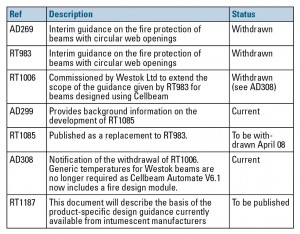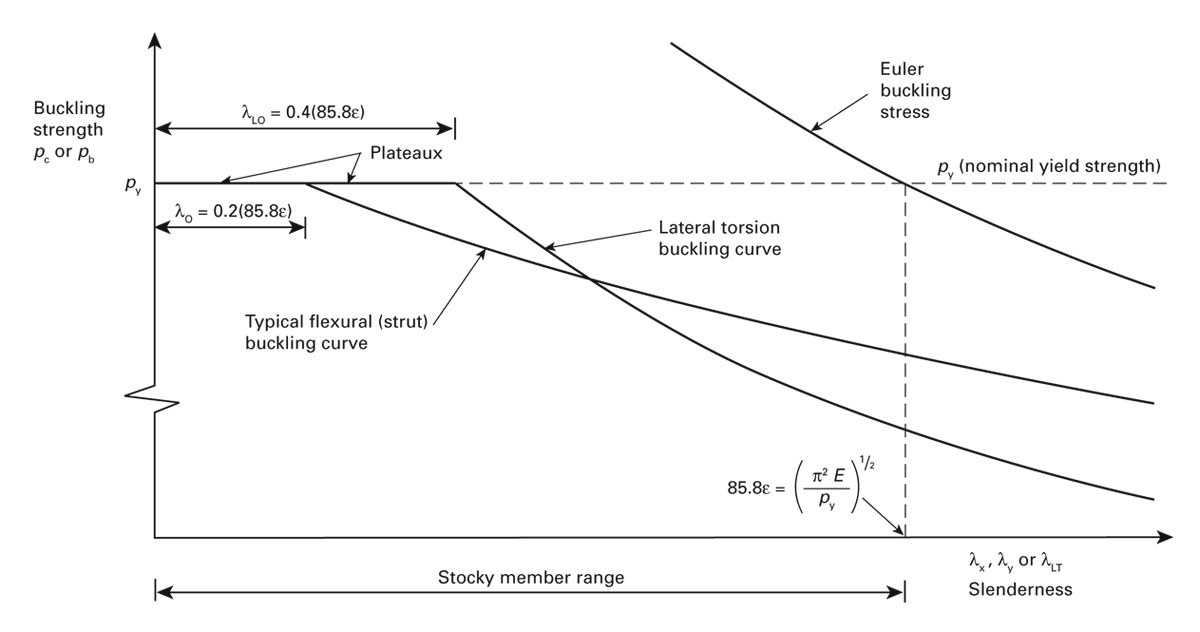Technical
AD 319: Update on the fire protection of beams with web openings.
 In the last five years there have been many developments in the fire protection of beams with web open- ings. For most cellular beams, that is beams with circular openings, fire protection requirements can be as- certained using simple tabular guid- ance. However, there are limitations on the opening geometry covered by existing simple guidance and for beams with rectangular openings or with a combination of circular and rectangular openings, there are no straightforward methods for as- sessing the fire protection require- ments. The issue of fire protection for all beams with web openings must therefore be addressed at the design stage, as the structural designer needs to ensure that a fire protection solution can be achieved for the proposed opening geometry. Failure to identify a fire protection solution prior to fabrication of the steelwork is often expensive to rectify. Structural designers need to be aware of the limitations of current fire design guidance when designing beams with web openings that will require fire protection, and if the beam geometry does not conform to those limits then the structural designer should make arrangements to supply the appropriate limiting temperatures to the fire protection specialist.
In the last five years there have been many developments in the fire protection of beams with web open- ings. For most cellular beams, that is beams with circular openings, fire protection requirements can be as- certained using simple tabular guid- ance. However, there are limitations on the opening geometry covered by existing simple guidance and for beams with rectangular openings or with a combination of circular and rectangular openings, there are no straightforward methods for as- sessing the fire protection require- ments. The issue of fire protection for all beams with web openings must therefore be addressed at the design stage, as the structural designer needs to ensure that a fire protection solution can be achieved for the proposed opening geometry. Failure to identify a fire protection solution prior to fabrication of the steelwork is often expensive to rectify. Structural designers need to be aware of the limitations of current fire design guidance when designing beams with web openings that will require fire protection, and if the beam geometry does not conform to those limits then the structural designer should make arrangements to supply the appropriate limiting temperatures to the fire protection specialist.
This advisory desk note provides an overview of the publications that have appeared and in some cases been withdrawn as the work on the fire resistance of these structural members has progressed. It also reviews the design options that are available for beams with web openings and provides advice on sources of further information where required, but it provides no new guidance.
The procedure for testing and assessing the performance of intu- mescent coatings for use on cellular beams has now been developed by ASFP in consultation with SCI and the fire testing laboratories. A number of intumescent manufactur- ers have tested their products in ac- cordance with this testing protocol and given this development it is now appropriate to withdraw generic guidance for the fire protection of cellular beams in favour of product- specific guidance.
Published Design Guidance
Research on beams with circular and rectangular web openings has shown that the design rule that had been developed for use with castel- lated beams and non reactive fire protection materials would underes- timate the thickness of fire protec- tion for cellular beams. As research in the area has developed, a number of documents offering design guid- ance have been produced; these are summarised in the adjacent table and their status given.
Design Methods
For optimum economy and struc- tural safety, the structural engineer should give the fire protection sup- plier appropriate limiting tempera- tures for each structural member, on the drawings and in the fire protec- tion specification. This is particularly important for beams with large web openings, as the limiting tempera- tures depend on the beam geometry, load level and load distribution properties with which the structural designer will be more familiar than the fire protection specialist.
The SCI recommends that limiting temperatures for beams with web openings protected using an intu- mescent coating are obtained using one of the following three options. These design options are not new guidance and have been described previously in AD299. In all cases SCI recommend that the fire protection product applied to the steelwork should be tested and assessed in accordance with the ASFP protocol for cellular beams.
If fire protection requirements cannot be ascertained using Option 1 (limited to beams with circular openings) or Option 2, structural de- signers should take responsibility for determining limiting temperatures using the advanced analysis meth- ods described in Option 3.
Option 1 – Tables of limiting temperatures
Simplified guidance is available from the fire protection manufactur- ers in the form of tables of limiting temperatures, but only for beams with circular web openings and geo- metrical limitations apply to the posi- tions and sizes of the openings. The structural designer should supply
suitable information on the geometry and loading, to enable the fire pro- tection manufacturer to determine an appropriate limiting temperature for the beam. Further advice is given in RT1187.
Option 2 – Proprietary Software
Proprietary beam design software that explicitly calculates the load carrying capacity for beams with web openings at the fire and ultimate limit states may be used.
The development of such software should be based on the observed temperature distribution throughout similar beams for different coating thicknesses and the observed performance of beams in loaded fire resistance tests. The software will give the values of limiting tempera- ture that are needed for the structur- al drawings and the fire protection specification.
Proprietary software that cov- ers the room temperature and fire design of their particular product is currently available from Fabsec and Westok. It should be noted that the results of analysis based on propri- etary software are only applicable to that structural product protected in accordance with the guidance provided by the software supplier.
Option 3 – Advanced analysis
Beams that are outside the scope of the fire protection manufactur- ers product-specific limiting tem- perature tables (notably beams with rectangular or elongated circular openings) and which have not been designed using proprietary software will need to be evaluated using advanced analysis in order to deter- mine the appropriate limiting temperature. As this advanced analysis is closely related to the structural design it should be undertaken by the structural designer or a suitability qualified consultant.
The structural model used for this purpose should take account of all practical modes of failure for beams with web openings and the thermal model should permit a suitable tem- perature distribution to be applied
to the cross section. The thermal model should take account of the increase in temperature of the web posts relative to the flanges and the effect of section asymmetry on top flange temperature. The perform- ance of the intumescent coating ap- plied to the beam should be compat- ible with this assumed temperature distribution used in the structural analysis. Data on the appropriate temperature distribution may be obtained from fire tests on protected sections or alternatively the thermal distribution given in RT1187 may be applied.
References
Fire Protection for Structural Steel in Buildings’, 4th ed, is available from www.asfp.co.uk
All the Advisory desk notes (includ- ing the withdrawn notes) and cur- rent SCI reports are available on www.Steelbiz.org.
Contact: Dr Ian Simms
Tel: 01344 636557
Email: i.simms@steel-sci.com










